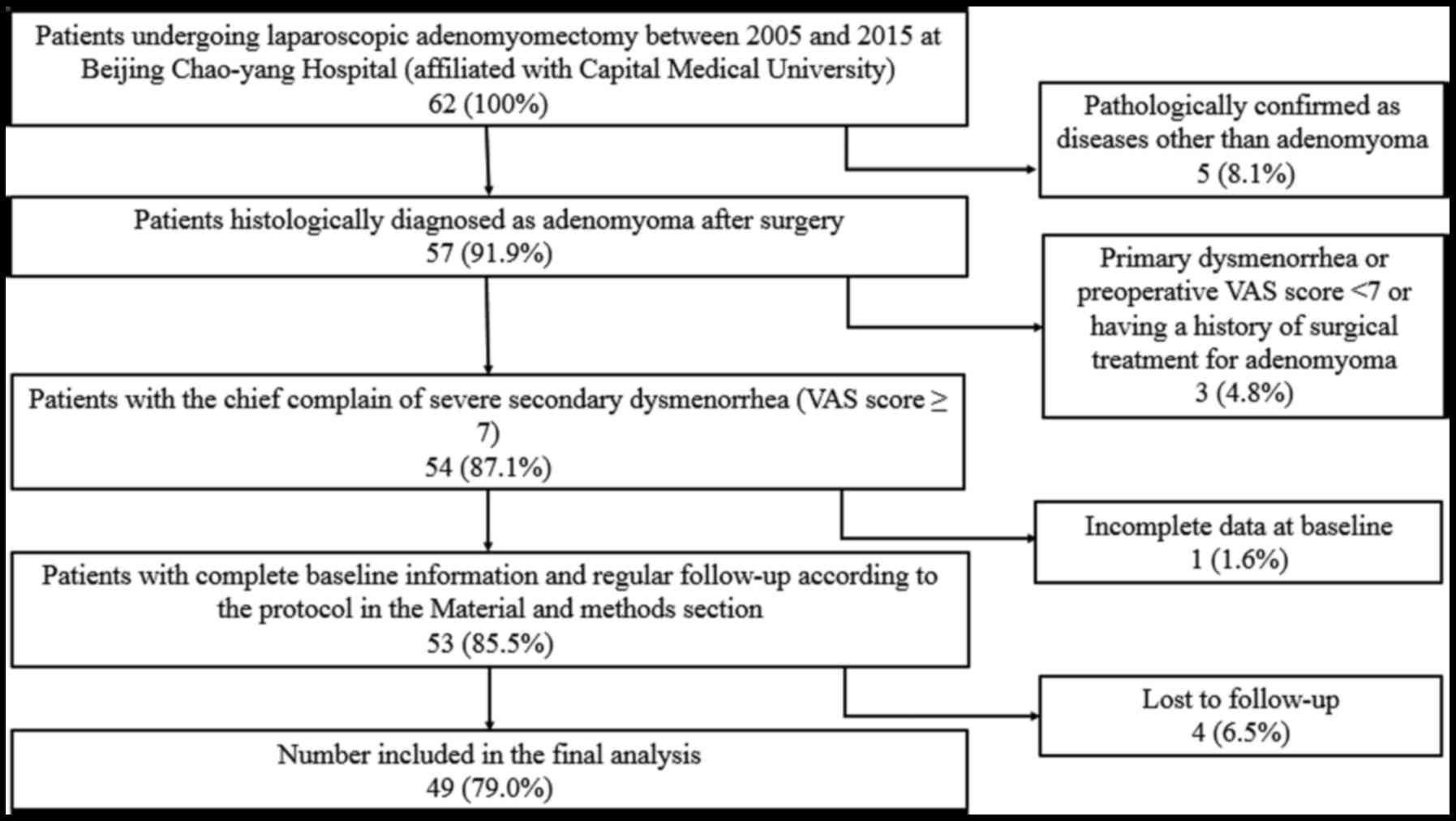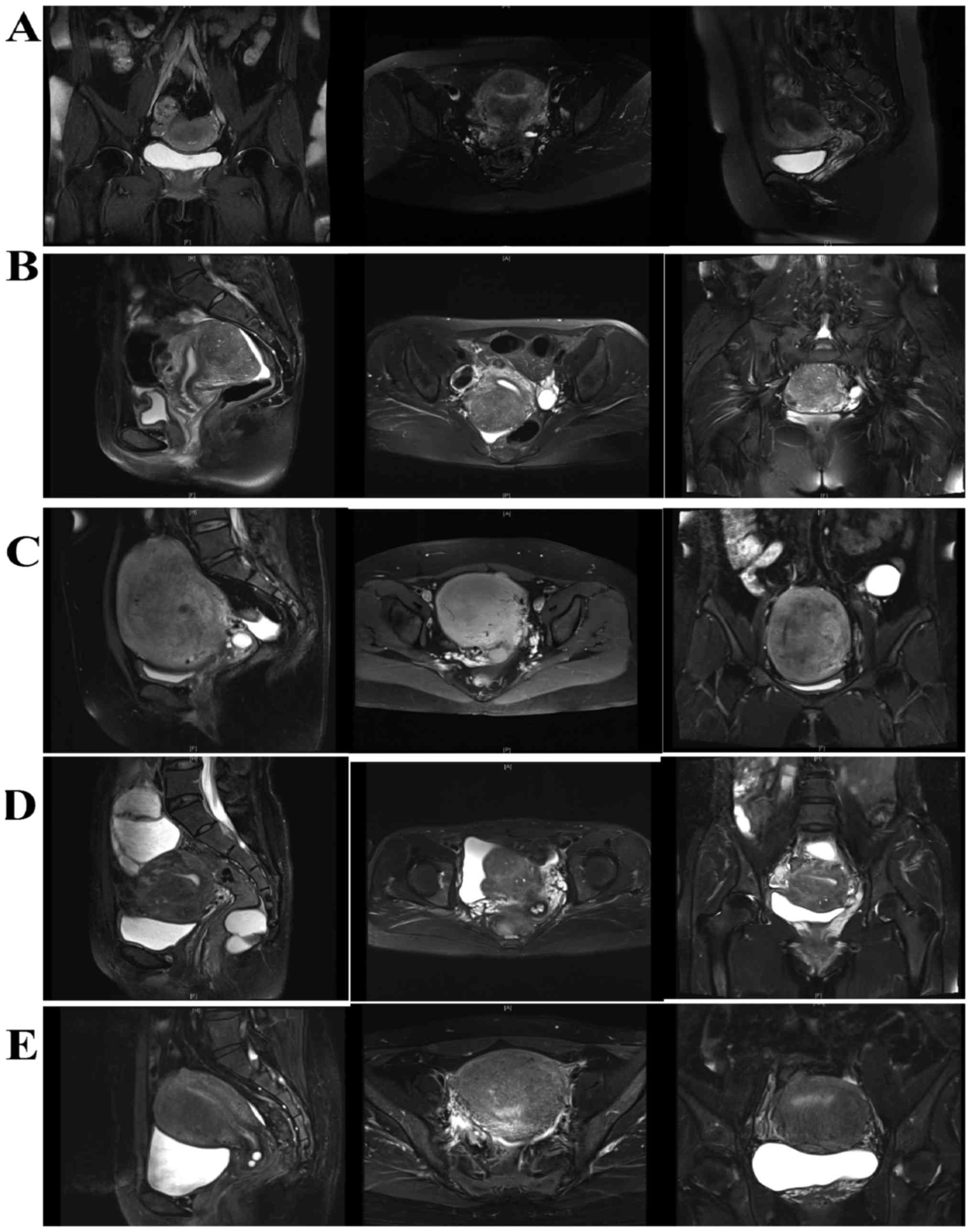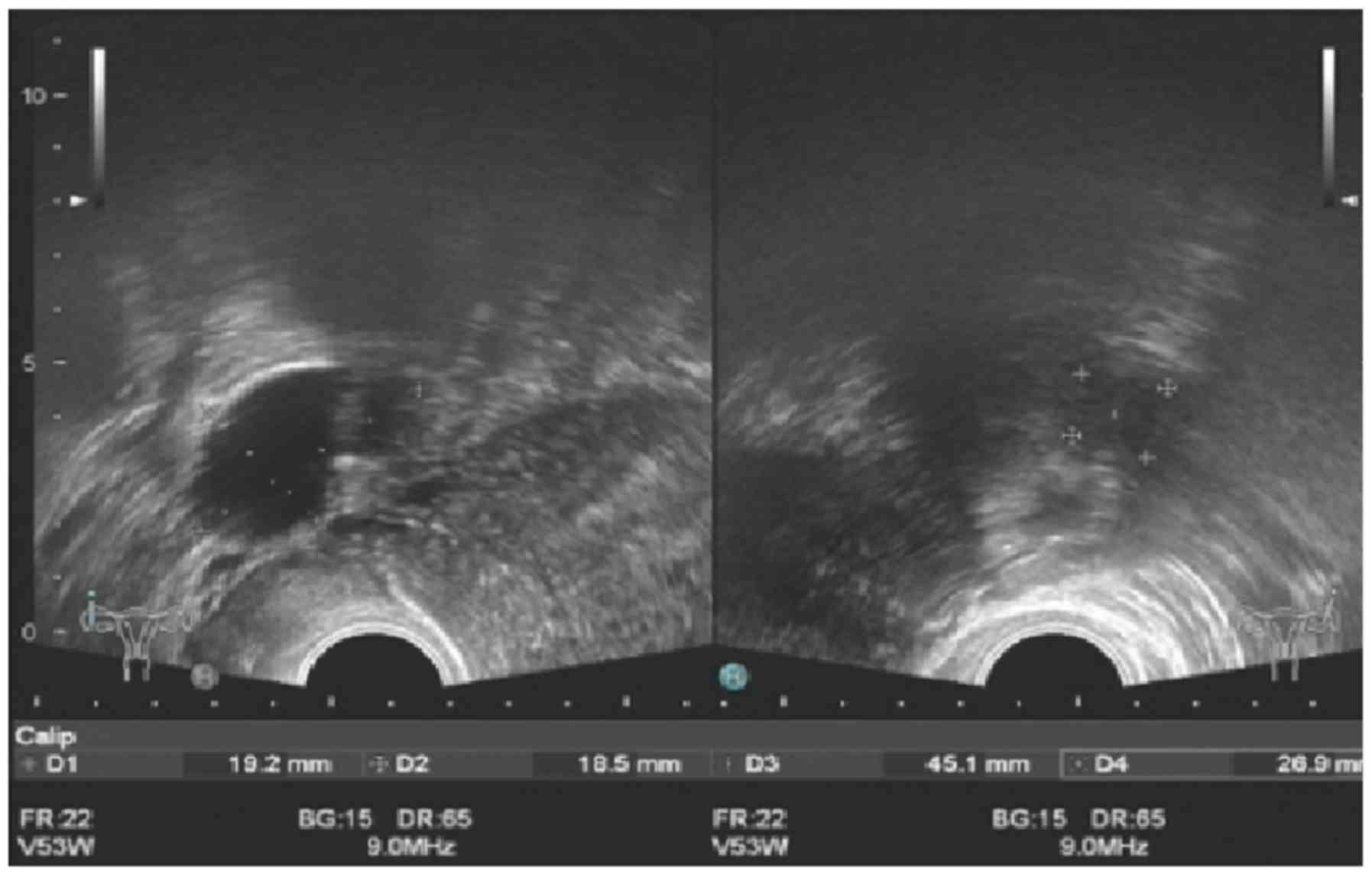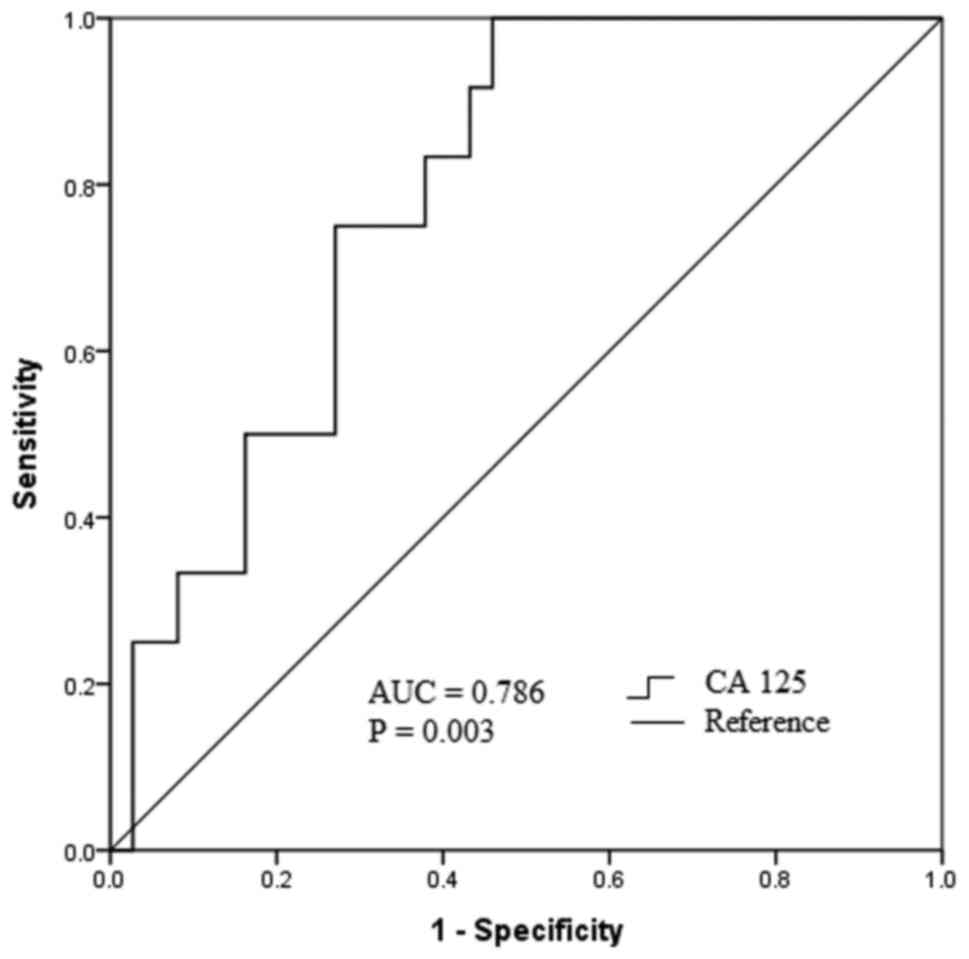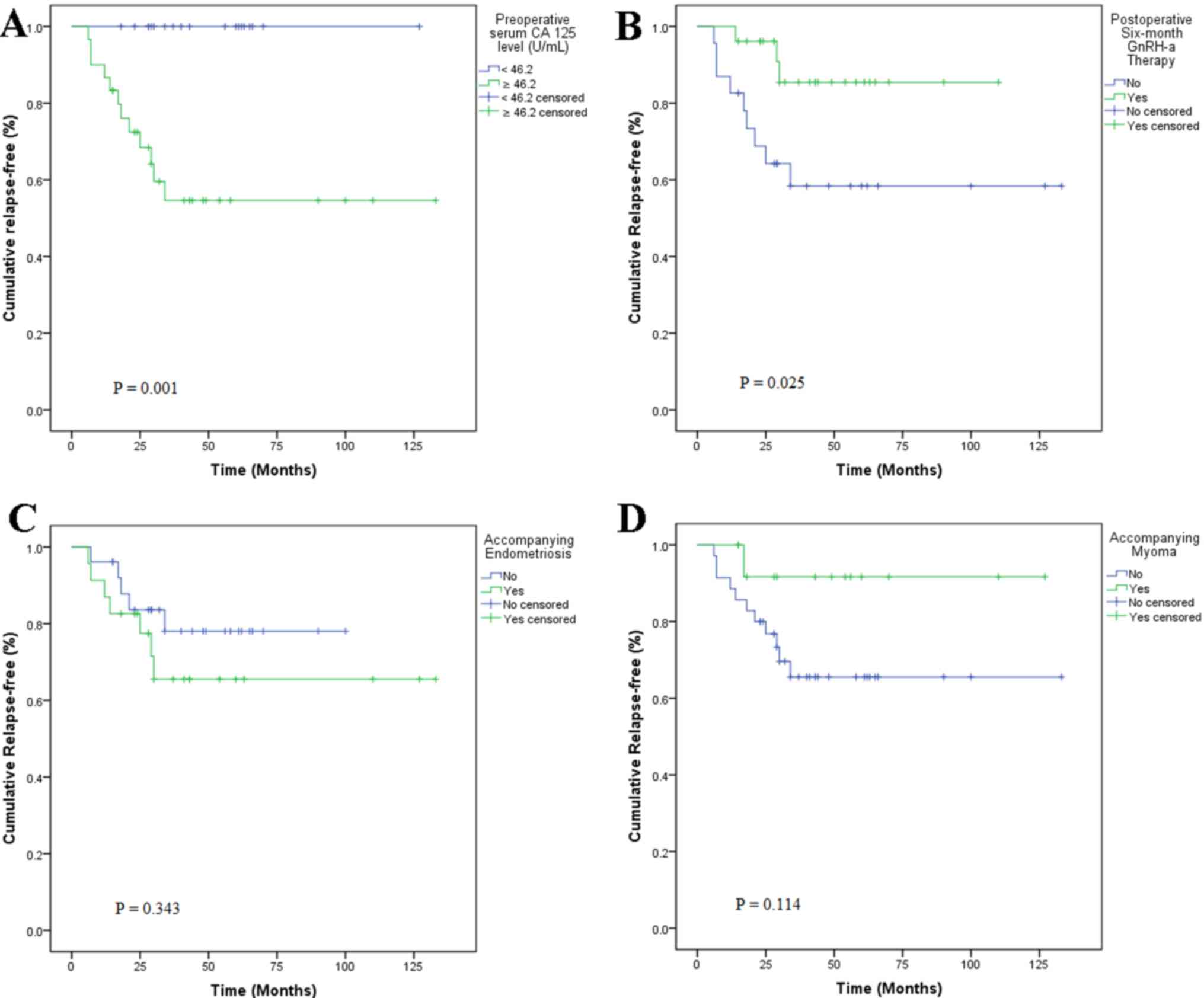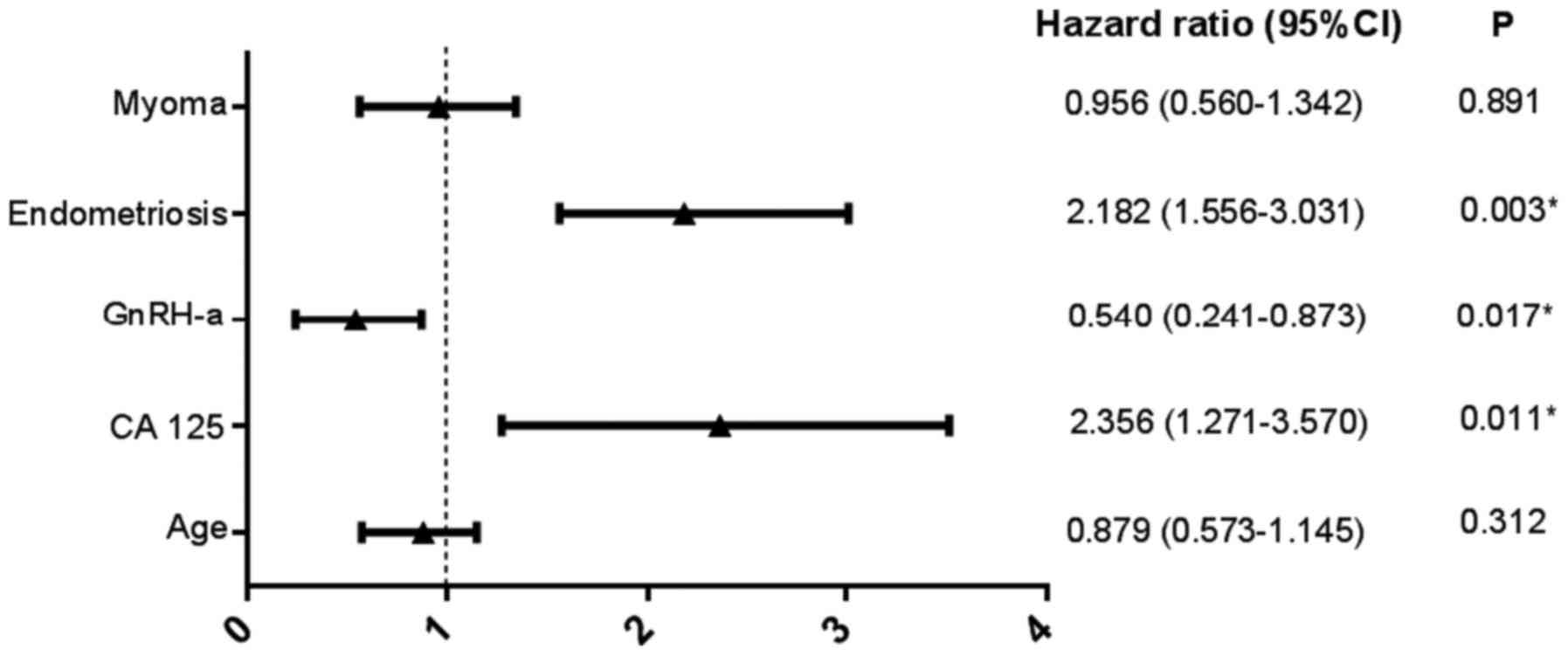|
1
|
Struble J, Reid S and Bedaiwy MA:
Adenomyosis: A clinical review of a challenging gynecologic
condition. J Minim Invasive Gynecol. 23:164–185. 2016. View Article : Google Scholar : PubMed/NCBI
|
|
2
|
Brosens I, Gordts S, Habiba M and
Benagiano G: Uterine cystic adenomyosis: A disease of younger
women. J Pediatr Adolesc Gynecol. 28:420–426. 2015. View Article : Google Scholar : PubMed/NCBI
|
|
3
|
Takeuchi H, Kitade M, Kikuchi I, Kumakiri
J, Kuroda K and Jinushi M: Diagnosis, laparoscopic management, and
histopathologic findings of juvenile cystic adenomyoma: A review of
nine cases. Fertil Steril. 94:862–868. 2010. View Article : Google Scholar : PubMed/NCBI
|
|
4
|
Tahlan A, Nanda A and Mohan H: Uterine
adenomyoma: A clinicopathologic review of 26 cases and a review of
the literature. Int J Gynecol Pathol. 25:361–365. 2006. View Article : Google Scholar : PubMed/NCBI
|
|
5
|
Pontis A, D'Alterio MN, Pirarba S, de
Angelis C, Tinelli R and Angioni S: Adenomyosis: A systematic
review of medical treatment. Gynecol Endocrinol. 32:696–700. 2016.
View Article : Google Scholar : PubMed/NCBI
|
|
6
|
Yavuzcan A, Başbuğ A, Baştan M, Çağlar M
and Özdemir İ: The effect of adenomyosis on the outcomes of
laparoscopic hysterectomy. J Turk Ger Gynecol Assoc. 17:150–154.
2016. View Article : Google Scholar : PubMed/NCBI
|
|
7
|
Garcia L and Isaacson K: Adenomyosis:
Review of the literature. J Minim Invasive Gynecol. 18:428–437.
2011. View Article : Google Scholar : PubMed/NCBI
|
|
8
|
Alabiso G, Alio L, Arena S, di Prun AB,
Bergamini V, Berlanda N, Busacca M, Candiani M, Centini G, Cello
AD, et al: Adenomyosis: What the patient needs. J Minim Invasive
Gynecol. 23:476–488. 2016. View Article : Google Scholar : PubMed/NCBI
|
|
9
|
Langley GB and Sheppeard H: The visual
analogue scale: Its use in pain measurement. Rheumatol Int.
5:145–148. 1985. View Article : Google Scholar : PubMed/NCBI
|
|
10
|
Wang PH, Liu WM, Fuh JL, Cheng MH and Chao
HT: Comparison of surgery alone and combined surgical-medical
treatment in the management of symptomatic uterine adenomyoma.
Fertil Steril. 92:876–885. 2009. View Article : Google Scholar : PubMed/NCBI
|
|
11
|
Grimbizis GF, Mikos T and Tarlatzis B:
Uterus-sparing operative treatment for adenomyosis. Fertil Steril.
101:472–487. 2014. View Article : Google Scholar : PubMed/NCBI
|
|
12
|
Younes G and Tulandi T: Conservative
surgery for adenomyosis and results: A systematic review. J Minim
Invasive Gynecol. 25:265–276. 2018. View Article : Google Scholar : PubMed/NCBI
|
|
13
|
Fujishita A, Masuzaki H, Khan KN, Kitajima
M and Ishimaru T: Modified reduction surgery for adenomyosis. A
preliminary report of the transverse H incision technique. Gynecol
Obstet Invest. 57:132–138. 2004. View Article : Google Scholar : PubMed/NCBI
|
|
14
|
Sun AJ, Luo M, Wang W, Chen R and Lang JH:
Characteristics and efficacy of modified adenomyomectomy in the
treatment of uterine adenomyoma. Chin Med J (Engl). 124:1322–1326.
2011.PubMed/NCBI
|
|
15
|
Nishida M, Takano K, Arai Y, Ozone H and
Ichikawa R: Conservative surgical management for diffuse uterine
adenomyosis. Fertil Steril. 94:715–719. 2010. View Article : Google Scholar : PubMed/NCBI
|
|
16
|
Kil K, Chung JE, Pak HJ, Jeung IC, Kim JH,
Jo HH and Kim MR: Usefulness of CA125 in the differential diagnosis
of uterine adenomyosis and myoma. Eur J Obstet Gynecol Reprod Biol.
185:131–135. 2015. View Article : Google Scholar : PubMed/NCBI
|
|
17
|
Seeber B, Sammel MD, Fan X, Gerton GL,
Shaunik A, Chittams J and Barnhart KT: Panel of markers can
accurately predict endometriosis in a subset of patients. Fertil
Steril. 89:1073–1081. 2008. View Article : Google Scholar : PubMed/NCBI
|
|
18
|
Kobayashi H, Ida W, Terao T and Kawashima
Y: Molecular characteristics of the CA 125 antigen produced by
human endometrial epithelial cells: Comparison between eutopic and
heterotopic epithelial cells. Am J Obstet Gynecol. 169:725–730.
1993. View Article : Google Scholar : PubMed/NCBI
|
|
19
|
Mihalyi A, Gevaert O, Kyama CM, Simsa P,
Pochet N, De Smet F, De Moor B, Meuleman C, Billen J, Blanckaert N,
et al: Non-invasive diagnosis of endometriosis based on a combined
analysis of six plasma biomarkers. Hum Reprod. 25:654–664. 2010.
View Article : Google Scholar : PubMed/NCBI
|
|
20
|
Bast RC Jr, Hennessy B and Mills GB: The
biology of ovarian cancer: New opportunities for translation. Nat
Rev Cancer. 9:415–428. 2009. View
Article : Google Scholar : PubMed/NCBI
|
|
21
|
Khan KN, Kitajima M, Hiraki K, Fujishita
A, Sekine I, Ishimaru T and Masuzaki H: Changes in tissue
inflammation, angiogenesis and apoptosis in endometriosis,
adenomyosis and uterine myoma after GnRH agonist therapy. Hum
Reprod. 25:642–653. 2010. View Article : Google Scholar : PubMed/NCBI
|
|
22
|
Jee BC, Lee JY, Suh CS, Kim SH, Choi YM
and Moon SY: Impact of GnRH agonist treatment on recurrence of
ovarian endometriomas after conservative laparoscopic surgery.
Fertil Steril. 91:40–45. 2009. View Article : Google Scholar : PubMed/NCBI
|
|
23
|
Vannuccini S, Tosti C, Carmona F, Huang
SJ, Chapron C, Guo SW and Petraglia F: Pathogenesis of adenomyosis:
An update on molecular mechanisms. Reprod Biomed Online.
35:592–601. 2017. View Article : Google Scholar : PubMed/NCBI
|
|
24
|
Gonzalez-Ramos R, Rocco J, Rojas C, Sovino
H, Poch A, Kohen P, Alvarado-Díaz C and Devoto L: Physiologic
activation of nuclear factor kappa-B in the endometrium during the
menstrual cycle is altered in endometriosis patients. Fertil
Steril. 97:645–651. 2012. View Article : Google Scholar : PubMed/NCBI
|
|
25
|
Naftalin J, Hoo W, Pateman K, Mavrelos D,
Holland T and Jurkovic D: How common is adenomyosis? A prospective
study of prevalence using transvaginal ultrasound in a gynaecology
clinic. Hum Reprod. 27:3432–3439. 2012. View Article : Google Scholar : PubMed/NCBI
|
|
26
|
Benagiano G, Brosens I and Habiba M:
Structural and molecular features of the endomyometrium in
endometriosis and adenomyosis. Hum Reprod Update. 20:386–402. 2014.
View Article : Google Scholar : PubMed/NCBI
|
|
27
|
Johnson NP, Farquhar CM, Crossley S, Yu Y,
Van Peperstraten AM, Sprecher M and Suckling J: A double-blind
randomised controlled trial of laparoscopic uterine nerve ablation
for women with chronic pelvic pain. BJOG. 111:950–959. 2004.
View Article : Google Scholar : PubMed/NCBI
|















